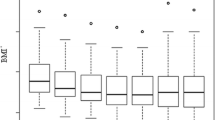Background
Intragastric balloons have been proposed to induce body weight loss in obese subjects. Most studies were performed using liquid-filled balloons. Air-filled balloons may increase digestive tolerance. Our goal was to study the tolerance and efficacy of a new air-filled intragastric balloon in nonmorbidly obese patients.
Methods
32 patients were included, with a mean BMI of 35.0 (range 30.1–40.0). The balloon was inserted under general anaesthesia, inflated with 800 ml of air, and removed 4 months later. Tolerance and body weight were monitored until 12 months after removal. Ghrelin levels were measured before balloon insertion, 1 and 4 weeks after, and before removal.
Results
Weight loss was significant at 1, 2 and 4 months after balloon insertion (6, 7 and 10 kg, respectively, P < 0.001). Early removal of the balloon occurred in 3 cases. 28 patients were contacted 12 months after balloon removal: 2 had undergone gastric banding; among the 26 remaining, the mean weight loss was 7 kg. 9 patients (30%) remained with a weight loss > 10%, and satisfaction with the method was 87% for these 9 patients, and 22% for the other patients who had weight loss < 10% (P < 0.04). Fasting plasma ghrelin levels increased at week 1 and 4 after balloon insertion, and decreased at week 16 (P < 0.001).
Conclusions
The air-filled intragastric balloon was safe. Its effect on weight loss appeared equivalent to other balloons. 12 months after balloon removal, 30% of the patients maintained a weight loss > 10%.
Similar content being viewed by others
References
WHO. Obesity: preventing and managing the global epidemic. Report of a WHO consultation on obesity. Geneva: WHO; 1998.
Mathus-Vliegen EM, Tytgat GN. Intragastric balloon for treatment-resistant obesity: safety, tolerance, and efficacy of 1-year balloon treatment followed by a 1-year balloon-free follow-up. Gastrointest Endosc 2005; 61: 19–27.
Genco A, Bruni T, Doldi SB et al. BioEnterics intragastric balloon: The Italian experience with 2,515 patients. Obes Surg 2005; 15: 1161–4.
Herve J, Wahlen CH, Schaeken A et al. What becomes of patients one year after the intragastric balloon has been removed? Obes Surg 2005; 15: 864–70.
Mion F, Napoleon B, Roman S et al. Effects of intragastric balloon on gastric emptying and plasma ghrelin levels in non-morbid obese patients. Obes Surg 2005; 15: 510–6.
Alfalah H, Philippe B, Ghazal F et al. Intragastric balloon for preoperative weight reduction in candidates for laparoscopic gastric bypass with massive obesity. Obes Surg 2006; 16: 147–50.
Milone L, Strong V, Gagner M. Laparoscopic sleeve gastrectomy is superior to endoscopic intragastric balloon as a first stage procedure for super-obese patients (BMI ≥50). Obes Surg 2005; 15: 612–7.
Melissas J, Mouzas J, Filis D et al. The intragastric balloon - smoothing the path to bariatric surgery. Obes Surg 2006; 16: 897–902.
Schapiro M, Benjamin S, Blackburn G et al. Obesity and the gastric balloon: a comprehensive workshop. Tarpon Springs, Florida, March 19–21, 1987. Gastrointest Endosc 1987; 33: 323–7.
Roman S, Napoleon B, Mion F et al. Intragastric balloon for “non-morbid” obesity: a retrospective evaluation of tolerance and efficacy. Obes Surg 2004; 14: 539–44.
Sallet JA, Marchesini JB, Paiva DS et al. Brazilian multicenter study of the intragastric balloon. Obes Surg 2004; 14: 991–8.
Al-Momen A, El-Mogy I. Intragastric balloon for obesity: a retrospective evaluation of tolerance and efficacy. Obes Surg 2005; 15: 101–5.
Forestieri P, De Palma GD, Formato A et al. Heliosphere Bag in the treatment of severe obesity: preliminary experience. Obes Surg 2006; 16: 635–7.
Kolotkin RL, Crosby RD, Kosloski KD et al. Development of a brief measure to assess quality of life in obesity. Obes Res 2001; 9: 102–11.
Nieben OG, Harboe H. Intragastric balloon as an artificial bezoar for treatment of obesity. Lancet 1982;1:198–9.
Boyle TM, Agus SG, Bauer JJ. Small intestinal obstruction secondary to obturation by a Garren gastric bubble. Am J Gastroenterol 1987; 82: 51–3.
Ulicny KS Jr, Goldberg SJ, Harper WJ et al. Surgical complications of the Garren-Edwards gastric bubble. Surg Gynecol Obstet 1988; 166: 535–40.
Mathus-Vliegen EM, Tytgat GN, Veldhuyzen-Offermans EA. Intragastric balloon in the treatment of super-morbid obesity. Double-blind, sham-controlled, crossover evaluation of 500-milliliter balloon. Gastroenterology 1990; 99: 362–9.
Doldi SB, Micheletto G, Perrini MN et al. Treatment of morbid obesity with intragastric balloon in association with diet. Obes Surg 2002; 12: 583–7.
Wright TA. Intragastric balloon in the treatment of patients with morbid obesity. Br J Surg 2002; 89: 489.
Zago S, Kornmuller AM, Agagliati D et al. [Benefit from bio-enteric Intra-gastric balloon (BIB) to modify lifestyle and eating habits in severely obese patients eligible for bariatric surgery]. Minerva Med 2006; 97: 51–64.
Totte E, Hendrickx L, Pauwels M et al. Weight reduction by means of intragastric device: experience with the bioenterics intragastric balloon. Obes Surg 2001; 11: 519–23.
Gale SM, Castracane VD, Mantzoros CS. Energy homeostasis, obesity and eating disorders: recent advances in endocrinology. J Nutr 2004; 134: 295–8.
Infanger D, Baldinger R, Branson R et al. Effect of significant intermediate-term weight loss on serum leptin levels and body composition in severely obese subjects. Obes Surg 2003; 13: 879–88.
Valsamakis G, McTernan Pg P, Chetty R et al. Modest weight loss and reduction in waist circumference after medical treatment are associated with favorable changes in serum adipocytokines. Metabolism 2004; 53: 430–4.
Druce MR, Small CJ, Bloom SR. Gut peptides regulating satiety. Endocrinology 2004; 145: 2660–5.
Cummings DE, Weigle DS, Frayo RS et al. Plasma ghrelin levels after diet-induced weight loss or gastric bypass surgery. N Engl J Med 2002; 346: 1623–30.
Author information
Authors and Affiliations
Corresponding author
Rights and permissions
About this article
Cite this article
Mion, F., Gincul, R., Roman, S. et al. Tolerance and Efficacy of an Air-filled Balloon in Non-morbidly Obese Patients: Results of a Prospective Multicenter Study. OBES SURG 17, 764–769 (2007). https://doi.org/10.1007/s11695-007-9141-z
Received:
Accepted:
Published:
Issue Date:
DOI: https://doi.org/10.1007/s11695-007-9141-z




